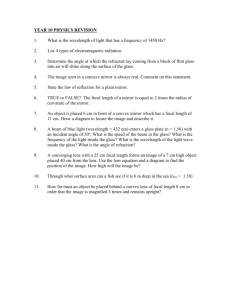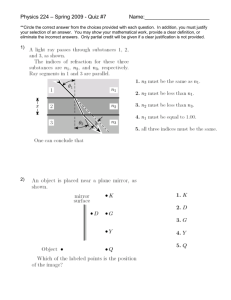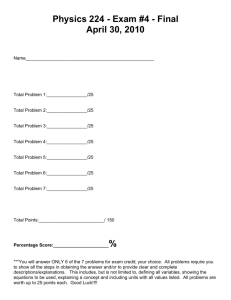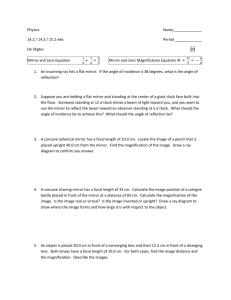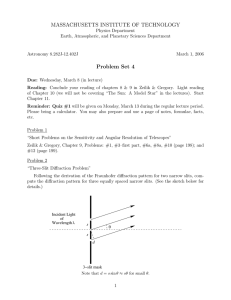PES 213 General Physics III
advertisement
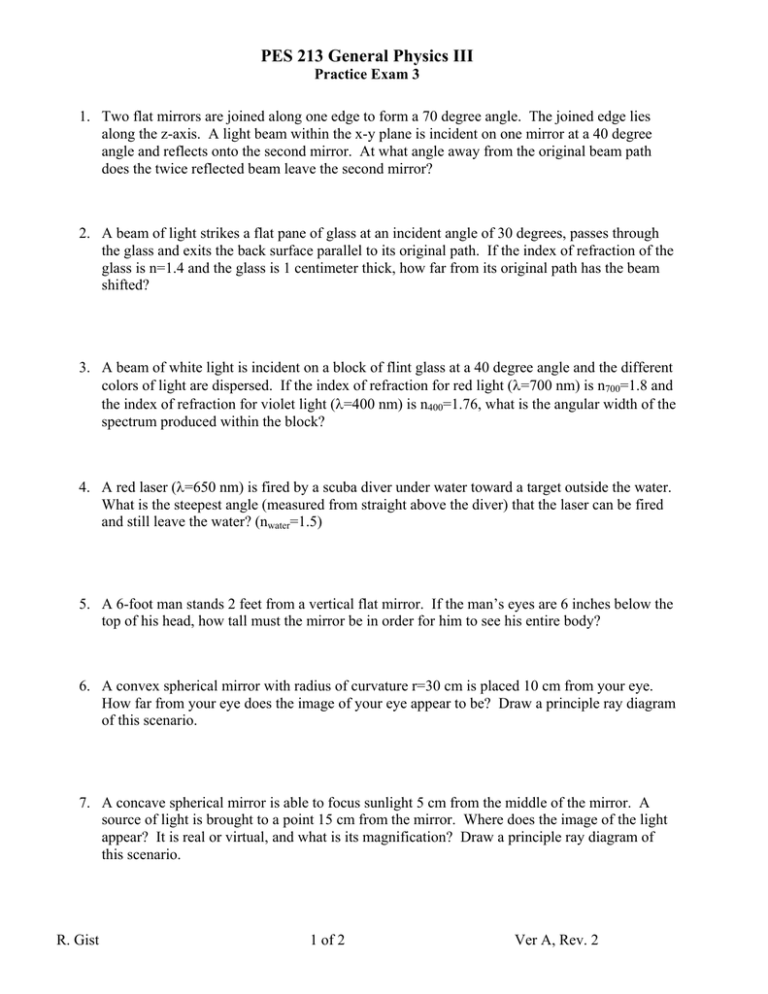
PES 213 General Physics III Practice Exam 3 1. Two flat mirrors are joined along one edge to form a 70 degree angle. The joined edge lies along the z-axis. A light beam within the x-y plane is incident on one mirror at a 40 degree angle and reflects onto the second mirror. At what angle away from the original beam path does the twice reflected beam leave the second mirror? 2. A beam of light strikes a flat pane of glass at an incident angle of 30 degrees, passes through the glass and exits the back surface parallel to its original path. If the index of refraction of the glass is n=1.4 and the glass is 1 centimeter thick, how far from its original path has the beam shifted? 3. A beam of white light is incident on a block of flint glass at a 40 degree angle and the different colors of light are dispersed. If the index of refraction for red light (λ=700 nm) is n700=1.8 and the index of refraction for violet light (λ=400 nm) is n400=1.76, what is the angular width of the spectrum produced within the block? 4. A red laser (λ=650 nm) is fired by a scuba diver under water toward a target outside the water. What is the steepest angle (measured from straight above the diver) that the laser can be fired and still leave the water? (nwater=1.5) 5. A 6-foot man stands 2 feet from a vertical flat mirror. If the man’s eyes are 6 inches below the top of his head, how tall must the mirror be in order for him to see his entire body? 6. A convex spherical mirror with radius of curvature r=30 cm is placed 10 cm from your eye. How far from your eye does the image of your eye appear to be? Draw a principle ray diagram of this scenario. 7. A concave spherical mirror is able to focus sunlight 5 cm from the middle of the mirror. A source of light is brought to a point 15 cm from the mirror. Where does the image of the light appear? It is real or virtual, and what is its magnification? Draw a principle ray diagram of this scenario. R. Gist 1 of 2 Ver A, Rev. 2 PES 213 General Physics III Practice Exam 3 8. A jeweler observes a tiny flaw under the flat surface of a diamond (n=2.45). It appears to be 1 mm beneath the surface. How far is the actual flaw beneath the surface? 9. A given symmetric double convex thin lens creates an image 20 cm from the lens when the original object is 10 cm from the lens. The image is inverted and real. What is the focal length of the lens? 10. A given symmetric double concave thin lens has a radius of curvature of r=10 cm. How big is the image of a 1 cm object placed 10 cm from the lens? Is the image real or virtual and is it upright or inverted? 11. In a re-creation of Young’s double-slit experiment, green light of wavelength λ=540 nm falls upon two parallel narrow slits which are 1 mm apart. An interference pattern is observed on a screen that is 2 meters away. What is the distance from the central bright fringe to the next bright fringe? 12. A narrow slit is cut in a sheet of paper and mono-chromatic light of wavelength λ=480 nm is shone on it. An interference pattern is observed on a screen that is 1 meter behind the paper. The width of the central bright fringe is measured to be 2 mm. How wide is the narrow slit? 13. White light strikes a soap bubble (nsoap_water=1.33) and an observer notes that a certain section of the bubble appears to be bright orange (λ=640 nm). What is the minimum thickness of the bubble at this section? 14. A ray of light (ray 0) is incident from air onto a thin layer of silicon monoxide which lies above a layer of silicon. Which of the following rays are in phase with the original (ray 0) and which are 180 degrees out of phase with the original? R. Gist 2 of 2 Ver A, Rev. 2
